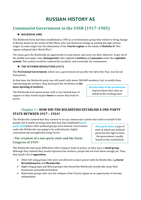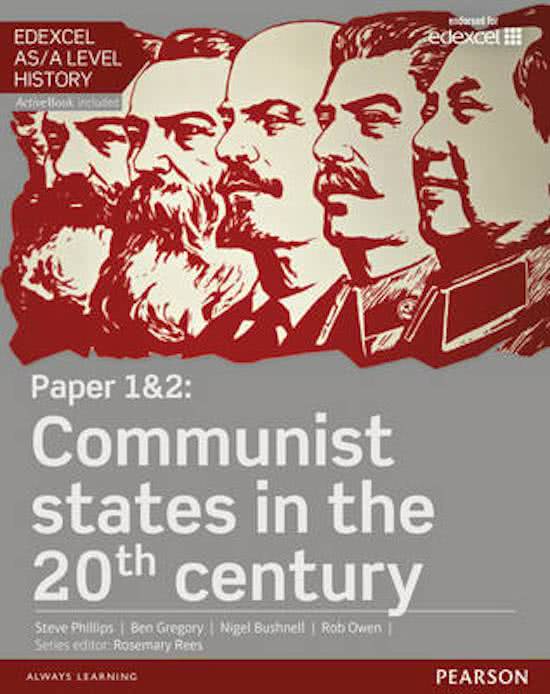RUSSIAN HISTORY AS
Communist Government in the USSR (1917-1985)
BOLSHEVIK AIMS
The Bolshevik Party had been established in 1903 as a revolutionary group that wished to bring change
in Russia, based on the works of Karl Marx, who saw historical change as passing through various
stages. Its main target was the elimination of the Tsarist regime in the hands of Nicholas II. This
regime collapsed after World War I.
The chaos gave the Bolsheviks an opportunity to seize power and carry out their objective: to get rid of
the middle and upper class (bourgeoisie) who exploited workers and peasants under the capitalist
system. This system would be replaced by socialism, and eventually, by communism.
THE OCTOBER REVOLUTION (1917)
The Provisional Government, which was a government set up after the fall of the Tsar, was forced
from power.
At that time, the Bolshevik party was still small, with about 300.000 members, but, to justify them
representing the workers, they portrayed the revolution as the
mass uprising of workers. Dictatorship of the proletariat:
A government that rules on
The Bolsheviks had seized power with a very limited base of
behalf of the working class.
support so they would require force to ensure they held on
power.
Chapter 1 – HOW DID THE BOLSHEVIKS ESTABLISH A ONE-PARTY
STATE BETWEEN 1917 – 1924?
The Bolsheviks claimed that they wanted to set up a democratic system that ruled on behalf of the
people, but it ended up being clear that they had established a one-
party statewhere other political groups were banned. Government One party state: a type of
under the Bolsheviks was going to be authoritarian, highly state in which one political
centralised and strengthened using Terror. party has the right to form
the government, usually
–The creation of a one-party state and the Party based on the constitution.
Congress of 1929–
The Bolsheviks had many difficulties when trying to hold on power, as they were a small group.
Although they claimed they would represent the workers, people did not trust them enough yet. Thus,
they faced a lot of opposition:
Other left-wing groups who were not allowed to share power with the Bolsheviks, e.g.Social
Revolutionaries and Mensheviks.
Right-wing groups and liberal groups who feared the Bolsheviks would take away their
businesses and political freedom.
Nationalist groups who saw the collapse of the Tsarist regime as an opportunity to become
independent.
, HOW DID THE BOLSHEVIKS DEAL WITH OTHER LEFT-WING GROUPS?
These groups shared many of the socialist views of the Bolsheviks so they hoped they would be given
part of the power in the new government, but Lenin denied it.
LeonTrotsky, Lenin’s closest associate quoted: ‘You have played out your role. Go where you belong: to
the dustbin of history’.
Even so, the SRs and the Mensheviks hoped that the calling of a parliament, the Constituent Assembly,
which was democratically elected, would be a chance to gain power. The results did not benefit the
Bolsheviks and the SRs emerged as the biggest single party. As the Assembly was now a threat to the
Bolsheviks, Lenin dissolved it, calling it an instrument of the
Constituent Assembly: A
bourgeoisie.
parliament elected by the
THE REMOVAL OF OTHER POLITICAL PARTIES people of Russia.
They removed the vote from the bourgeoisie classes.
The Mensheviks and SRs could not publish their newspapers easily due to restrictions.
The left-wing SRs lost their influence when they protested about the decision of the Bolsheviks
to exit WW1 in 1918.
In 1918 they renamed themselves as the Communist Party, banning all the other political
parties.
In 1921, Lenin started chasing them and putting them in prison.
THE TREATY OF BREST-LITOVSK (1918)
It’s the treaty by which peace was set. It took Russia out of war, but had devastating consequences for
the country: Russia lost control over the Baltic States of Lithuania, Estonia and Latvia, Finland, Ukraine
and part of the Caucasus region. The conservatives thought of this as a humiliation that could not be
tolerated and wanted to overthrow the Bolshevik government to reject the treaty.
The Treaty also provided help to those who wished to fight against the Bolsheviks, known as the
Whites to ensure that Russia returned to war.
Why did Lenin sign the Treaty of Brest-Litovsk if it increased opposition and likelihood of civil war
then?
Lenin knew that what had made the Tsarist regime and the Provisional Government collapse was the
pressure of fighting WWI. It ate up energy and resources without giving much back. He realised that if
he wanted to progress, he’d have to pull out of war.
THE RUSSIAN CIVIL WAR (1917-1922)
When the Bolsheviks seized power in Russia in 1917 they faced the challenge of trying to run an
enormous country with big problems. By 1918 they faced an alliance of enemies, known as the Whites.
The White opposition was composed of liberals, military leaders, national minorities, Menshevik and
SR parties and the Czech Legion with help from the Allies. They opposed the Bolsheviks,
especially because of the Brest-Litovsk Treaty. In March 1918, they seized control of the
Trans-Siberian railway.
At the same time, foreign troops also entered the war to defeat the Bolsheviks. They were Russia’s
former allies, furious that Lenin had pulled out of war in 1918.
In July 1918 Lenin ordered the execution of the Tsar and his family because the Whites could’ve had
rescued him.
, The Bolshevik’s advantages
Much credit must go to Trotsky, who was a brilliant War Commissar and seemed to be a natural
leader. He visited the Red troopsby train all over Russia to motivate them.
Men wanted to join the Red army because Lenin had ordered that food taken from the peasants
was given to the troops.
The Reds weren’t fighting a cohesive army. The Whites were made up of many groups and
nationalities, so their ideas collided, making them uncoordinated. This included disunited
attacks and no sole commander.
The Whites did not have a good reputation in the Russian areas they controlled. There were
peasants everywhere and since Lenin had promised them peace, land and bread, they were on
the Bolshevik side.
The Whites had also had a lack of good communication, since the railways they controlled
tended to pass through Bolshevik areas. Thus, the Reds had good geographical communication
while the Whites didn’t.
Even though the Allies provided supplies to the Whites, they didn’t make a good use of them.
The Bolshevik’s difficulties
Famine: Feeding the Red army by taking away the food from the peasants caused famine and
led to cannibalism.
The Bolshevik’s own supporters opposed them because they were fed up of war. Trotsky took
care of it.
Attacks on Lenin: Opposition and people on their own side attempted to assassin him. Lenin’s
response was to launch more terror to scare them.
The consequences of the Civil War
The Bolshevik Party became more centralised, in the hands of the Government (Sovnarkom) and
Party leadership (Politburo). This was because fighting a war required quick decision-making.
The Bolsheviks made extensive use of Terror against their political opponents before the CW, but
after too.
The old Bolsheviks, those who had fought in the war, had been affected deeply and no longer thought
twice about using force and Terror.
Attitude to opposition of the Party changed:
-They banned the creation of factions to impose their leadership.
-Those who disagreed were thrown out.
Overall, the results of the Civil War were highly influential in the Bolshevik’s system of government,
turning it into a more radical one.
THE TENTH PARTY CONGRESS (1921)
After the Civil War, hatred against the Bolshevik Party rose. As the Party broadened (it went from
300.000 to 730.000 members), factions had broken out, which threatened stability. There started to be
mutinies and uprisings as well, putting the Party’s position in danger.
Krondstadt Mutiny: A revolt of sailors previously loyal to the Bolsheviks because of the failure of
the economic policy of War Communism, which caused food shortages and bad conditions.





